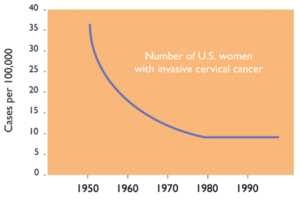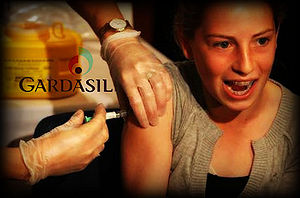Public Health Measures Against HPV
Introduction
To start your own paper: Type your page title into the Search box. (Be sure to spell correctly.) Press "Go." The site will offer you the opportunity to "Create this page."
Next, use the "edit" tab to reveal the coded file of BIOL 191 Paper 2009. Select all and copy; paste into the edit window of your own page. (Do not try to edit the class page.)
Introduce the topic of your paper. What public health question do you raise? Whose health is affected; in what country or location? What disease organisms are involved?
Below are some sample codes that will be useful for your paper.
To upload an image: Use "Upload File" (in margin at left)
To make the image appear, you need to embed image insertion code (see sample at right). The insertion code consists of:
Double brackets: [[
Filename: PHIL_1181_lores.jpg
Thumbnail status: |thumb|
Pixel size: |300px|
Placement on page: |right|
Legend/credit: Electron micrograph of the Ebola Zaire virus. This was the first photo ever taken of the virus, on 10/13/1976. By Dr. F.A. Murphy, now at U.C. Davis, then at the CDC.
Closed double brackets: ]]
Other examples:
Bold
Italic
Subscript: H2O
Superscript: Fe3+
The Different Strains of HPV
Include some current research in each section.
The Vaccine and Other Public Health Measures
Because sexually active women have such a high chance of contracting any type of HPV and certain types have been shown to cause genital warts and cervical cancer, there is a prominent public health movement to try to help prevent women from getting HPV and thus, prevent women from getting cervical cancer. All women are strongly encouraged to get tested regularly. The Pap test and the HPV test are both tests which are used to detect HPV. HPV causes abnormal cells in the cervix and the Pap test scans for these abnormalities. The HPV test, on the other hand, looks for the virus that would cause an HPV infection. Regular testing gives doctors the ability to catch the virus before it develops into something more serious. Because of this, public health officials market these two tests as a way of preventing cervical cancer. Women should get their first Pap test three years after their first sexual intercourse, or when they turn 21. For women under 30, regular test is not necessary because the virus usually goes away on its own without causing complications in young women. Women under 30 should only have an HPV test if the results of their Pap test are unclear. For women over 30, public health workers suggest that they should be tested regularly (once or twice a year). In this age demographic, HPV infections are more likely to be long lasting and thus, have a higher risk of causing cervical cancer. Women over 30 should have a Pap test and an HPV because sometimes the two yield different results. Sometimes a Pap test can be clear but an HPV test can show signs that a patient has a high-risk of developing cervical cancer, if the results show signs of an HPV infection. (http://www.thehpvtest.com/Resource-Center/~/media/Files/QIAGENCMS/Corporate/Web/TheHPVTest/Resources/Brochure/Brochure_EN.ashx).
In the last few years, a vaccine, called GARDASIL, has been developed to protect women against the types of HPV most likely to cause genital warts (types 6 and 11) and cervical cancer (types 16 and 18). The standard 3 doses over a 6 month period is recommended for all females between ages 9 and 26. GARDASIL only protects against the contraction of the virus, it does not protect against diseases it causes, nor does it treat those diseases. For this reason, it is important to get tested regularly for HPV even if a woman has received the vaccine (http://www.gardasil.com/what-is-gardasil/index.html). Also, the GARDASIL vaccine is only effective if the patient receives all three rounds. According to the Center for Disease Control, the vaccine is highly effective in preventing the four types of HPV that its designed to prevent. The most common side effect of GARDASIL is soreness in the arm where the shot was given. (http://www.cdc.gov/vaccines/vpd-vac/hpv/hpv-vacsafe-effic.htm). However there can be serious risks of receiving the vaccine if a patient is allergic to one of the ingredients in the vaccine or allergic to yeast. All girls who plan on receiving GARDASIL should consult their doctor before doing so (http://www.gardasil.com/#important-information).
.

The Vaccine is not an easy way out for Public Health Workers
Include some current research in each section.
The Vaccine is effective, but do all girls need it?
Overall paper length should be approximately 2,000 to 2,500 words.
Include at least two data figures.
Use professional sources, including at least two research studies.
References
Edited by student of Joan Slonczewski for BIOL 191 Microbiology, 2009, Kenyon College.

